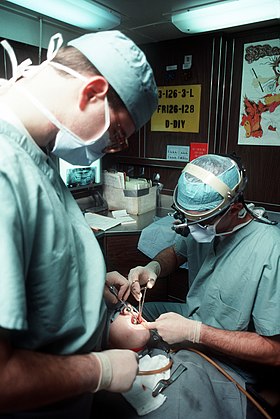Dental surgeons
| Dental surgery | |
|---|---|

|
|
| ICD-10-PCS | 0C?W-X) |
| ICD-9-CM | 23-24 |
| MeSH | D003813 |
Dental surgery is any of a number of medical procedures that involve artificially modifying dentition; in other words, surgery of the teeth and jaw bones.
Some of the more common are:
Regular tooth cleaning by a dental professional is recommended to remove tartar (mineralized plaque) that may develop even with careful brushing and flossing, especially in areas of the mouth that are difficult to clean. Professional cleaning includes tooth scaling and tooth polishing, as well as debridement if too much tartar has accumulated. This involves the use of various instruments and/or devices to loosen and remove tartar from the teeth. Most dental hygienists recommend having the teeth professionally cleaned at least every six months.
More frequent cleaning and examination may be necessary during the treatment of many different dental/oral disorders or due to recent surgical procedures such as dental implants. Routine examination of the teeth by a dental professional is recommended at least every year. This may include yearly, select dental X-rays. See also dental plaque identification procedure and removal.
Dentists inject anesthetic to block sensory transmission by the . The are not usually anesthetized directly because they are difficult to approach with a needle. For this reason, the maxillary teeth are usually anesthetized locally by inserting the needle beneath the oral mucosa surrounding the teeth. The inferior alveolar nerve is probably anesthetized more often than any other nerve in the body. To anesthetize this nerve, the dentist inserts the needle somewhat posterior to the patient’s last molar.
...
Wikipedia
